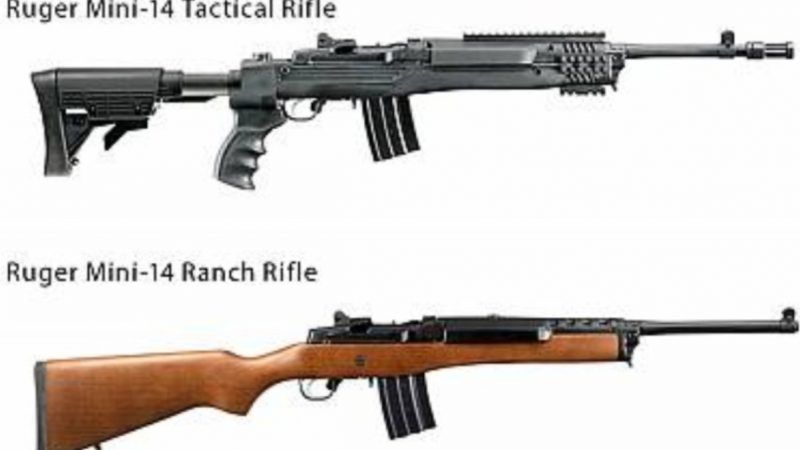A Suspiciously Selective, Logically Shaky Analysis of Mass Shooting Data Claims the Federal 'Assault Weapon' Ban 'Really Did Work'
The law's impact on weapon choice cannot plausibly account for reductions or increases in fatalities.

Stanford law professor John Donohue claims to have discovered evidence that the 1994 federal ban on so-called assault weapons "really did work," because mass shootings and the deaths caused by them declined while the law was in effect, then rose afterward. But the methodology Donohue used is suspiciously selective, and his results do not show what he thinks they do.
"Public mass shootings—which we defined as incidents in which a gunman killed at least six people in public—dropped during the decade of the federal ban," Donohue and Stanford student Theodora Boulouta write in a New York Times op-ed piece published yesterday. "Yet, in the 15 years since the ban ended, the trajectory of gun massacres has been sharply upward, largely tracking the growth in ownership of military-style weapons and high-capacity magazines."
Donohue and Boulouta relied on the Mother Jones database of mass shootings, which includes "indiscriminate rampages in public places resulting in four or more victims killed by the attacker." Yet they chose to focus on cases with six or more fatalities, for no obvious reason except that it exaggerates the changes they attribute to the "assault weapon" ban that expired in 2004.
Based on the definition used by Mother Jones, there were 16 mass shootings, involving 125 fatalities, during the 10 years before the "assault weapon" ban took effect on September 13, 1994. During the 10 years when the law was in effect, there were 15 mass shootings with 96 fatalities. That represents a slight decline in a rare kind of crime, and it is by no means clear that the ban had anything to do with it.
As Donohue and Boulouta note, violent crime in general was falling throughout that period. Furthermore, the law targeted guns based on "military-style" features, such as folding stocks, pistol grips, and threaded barrels, that had little or nothing to do with their lethality in the hands of mass shooters, and it left more than 1.5 million "assault weapons" in circulation.
Limiting their analysis to shootings in which six or more victims were killed, Donohue and Boulouta report that the "federal assault weapon ban in effect from September 1994 through 2004 was associated with a 25 percent drop in gun massacres (from eight to six) and a 40 percent drop in fatalities (from 81 to 49)." Those are bigger drops than the Mother Jones database shows, but only because Donohue and Boulouta arbitrarily excluded mass shootings that killed four or five people.
Having magnified the decrease associated with the "assault weapon" ban through careful case selection, Donohue and Boulouta suggest the change must be due to the law. "This decline is plausible because assault weapons are semiautomatic firearms designed for rapid fire and combat use, and large-capacity magazines increase the number of rounds that can be fired without reloading," they say. "While the gun lobby prevented the ban from being as effective as it could have been and saddled the law with a 10-year sunset provision, the ban did impede the easy access to the type of lethal weaponry that those intent on mass killing have readily available in most of the country today."
Contrary to Donohue and Boulouta's implication, neither rate of fire nor the capacity to accept detachable magazines distinguished the guns covered by the 1994 law from the guns that remained legal. In any case, the numbers do not suggest that the ban had much of an impact on the weapons used by mass shooters. By my count, guns covered by the ban were used in six out of 16 mass shootings (38 percent) in the decade before it was enacted, compared to five out of 15 (33 percent) while it was in effect. Even leaving aside the functional similarity between banned and legal guns, it seems clear that the slight change in the mix of weapons cannot explain the 23 percent drop in fatalities, especially since the two deadliest pre-ban mass shootings, accounting for nearly a third of the fatalities during that 10-year period, were carried out with ordinary handguns.
What about after the ban expired? In the subsequent decade, there was indeed a big increase in mass shootings and fatalities caused by them. Based on the Mother Jones tally, there were 36 mass shootings with nearly 300 fatalities. Is that because "assault weapons" were easier to get? Again, the numbers suggest otherwise. Guns that would have been covered by the 1994 ban—or, in at least one case, would be covered by the revised version that Sen. Dianne Feinstein (D-Calif.), who sponsored the original ban, has introduced—were used in seven of those attacks, or 19 percent. In other words, "assault weapons" were less commonly used in mass shootings after the ban than they were during it.
Donohue and Boulouta claim that the expiration of the federal ban "permitt[ed] the gun industry to flood the market with increasingly powerful weapons that allow for faster killing." But so-called assault weapons are no "faster" or more "powerful" than functionally similar guns that do not fall into that arbitrary category. They fire the same ammunition at the same rate with the same muzzle velocity. The causal mechanism that Donohue and Boulouta have in mind is therefore rather mysterious, since banning "assault weapons," even if it made all of them disappear overnight, would leave mass shooters with plenty of equally deadly alternatives.
[This article has been revised to correct the number of mass shootings in which "assault weapons" were used before the ban and while the ban was in effect.]


Show Comments (131)